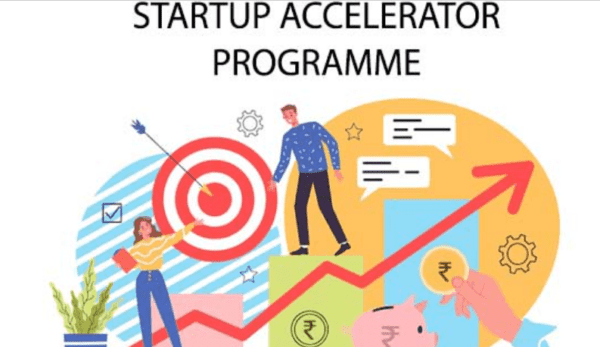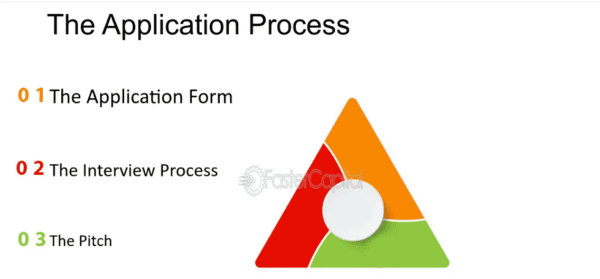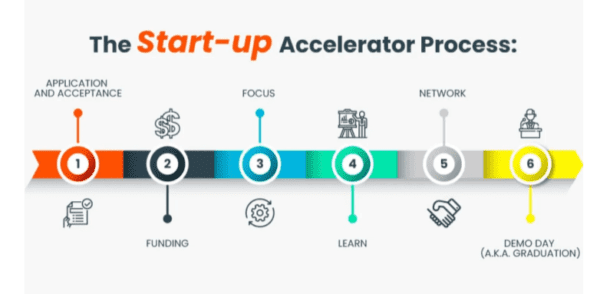If you’re an entrepreneur with an excellent idea for a startup, you may be wondering how to get it off the ground. One option is to participate in a startup accelerator program. A startup accelerator program is designed to help early-stage startups grow and succeed.
The accelerator process typically involves a period of intensive mentorship and coaching, as well as access to funding, resources, and networking opportunities. During the program, you’ll work with experienced entrepreneurs and industry experts who can help you refine your business model, develop your product, and navigate the challenges of launching a startup. At the end of the program, you’ll have the opportunity to pitch your company to investors and potentially secure additional funding.
Startup accelerators can be a great way to jumpstart your entrepreneurial journey and take your startup to the next level. However, it’s essential to research and carefully choose the right accelerator for your needs. Each program has its focus, requirements, and benefits, so finding one that aligns with your goals and values is vital. With the right accelerator program and hard work, you can make your startup dream a successful reality.

Accelerator Process-Understanding Startup Accelerators
You might have heard of startup accelerators if you are an early-stage startup business. A startup accelerator, also known as a seed accelerator, is a program that provides funding, mentorship, and resources to help startups grow and succeed. This section will define accelerator programs and discuss their history and evolution.
Defining Accelerator Programs
Startup accelerators are designed to expedite the growth of existing companies. They typically offer a three to six-month short-term program that provides startup mentorship, office space, funding, and networking opportunities. In exchange for these resources, startups usually give up a small percentage of their equity to the accelerator.
Accelerator programs, such as healthcare or fintech, can be industry-specific or generalist programs that accept startups from various industries. Some popular startup accelerators include Y Combinator, Techstars, and 500 Startups.
Accelerator programs differ from business incubators in that they focus on startups that have already launched their product or service and are looking to scale quickly. On the other hand, business incubators are designed to help startups during the early stages of development, providing resources such as office space, mentorship, and funding.

History and Evolution
The first startup accelerator was launched in 2005 by Paul Graham, founder of Y Combinator. Since then, the number of startup accelerators has grown significantly. In 2015, over 200 startup accelerators were in the United States alone.
In recent years, corporate accelerators have also become popular. The accelerator programs are run by large corporations, such as Microsoft or Google, to help startups work on technologies relevant to their business.
Overall, startup accelerators have become essential to the startup ecosystem, providing startups with the necessary resources to grow and succeed.
The Accelerator Application Process
Suppose you’re a startup founder looking to join an accelerator pro. You must go through a rigorous application process. This section will take you through the critical steps involved in the application process.
Selection Criteria
Accelerator programs typically have a set of criteria to evaluate startups that apply to their program. These criteria are designed to identify startups that have the potential to succeed and that are a good fit for the program standard on selection criteria include:
- Team: Accelerators look for those with a mix of skills and experience. They want to see that the team has what it takes to execute their vision.
- Product: Accelerators want to see that the startup has a product that solves a real problem for a specific market.
- Market: Accelerators want to see the startup targeting a large and growing market.
- Traction: Accelerators want to see that the startup has some early traction, such as customers, revenue, or user engagement.
- Potential: Accelerators want to see that the startup has the potential to scale and become a successful business.

Application Steps
The application process for accelerators typically involves several steps. These steps may vary depending on the program and usually include the following:
- Online application: The first step is to submit an online application. This application typically requires your team, product, market, and traction information. You may also be asked to provide a pitch deck or video.
- Interviews: If your application is selected, you’ll be invited to participate in one or more interviews. These interviews may be conducted in person or online and may involve multiple members of the accelerator team.
- Due diligence: After the interviews, the accelerator team will conduct due diligence on your startup. This may involve checking references, reviewing financials, and conducting background checks.
- Selection: Finally, the accelerator team decides whether to accept your startup into the program.
Acceptance Rate
Accelerator programs are highly competitive, and acceptance rates can be low. For example, top-tier accelerators such as Y Combinator and Techstars have acceptance rates as low as 1%-2%. However, the acceptance rate can vary depending on the program and the number of applications they receive.
The accelerator application process is rigorous, competitive, and requires much time and effort. However, if accepted into an accelerator program, it can provide the resources, mentorship, and network you need to take your startup to the next level.

Program Structure and Benefits
If you’re considering joining a startup accelerator program, it is essential to understand what you can expect from the program structure and what benefits you can gain from participating. Here are some of the key elements you can expect from most startup accelerator programs:
Duration and Schedule
Startup accelerator programs typically last for a fixed period, usually for three to six months. Be expected to work intensively on your start during this time, attending regular meetings and workshops with your cohort and mentors. The schedule will be structured, with specific deadlines and milestones to meet along the way.
Mentorship and Support
One of the key benefits of joining a startup accelerator program is the mentorship and support you’ll receive. You’ll be matched with experienced entrepreneurs and industry experts who can provide guidance and advice on everything from product development to fundraising. You’ll also have access to a network of investors, lawyers, and other professionals who can help you grow your business.

Educational Components
Most startup accelerator programs include educational components designed to help you develop the skills and knowledge you need to succeed as an entrepreneur. This includes marketing, sales, and fi workshops and one-on-one coaching sessions with mentors.
Networking Opportunities
Finally, joining a startup accelerator program can provide valuable networking opportunities. You’ll be part of a cohort of like-minded entrepreneurs who can help you build relationships and essential connections in your industry. You’ll also have the opportunity to pitch your business to investors and other stakeholders, which can help you secure funding and grow your businessParticipatingng in a startup accelerator program can be an excellent way to accelerate your business growth and gain the skills and knowledge you need to succeed as an entrepreneur. If you’re considering joining a page, research your options carefully and choose a program that aligns with your goals and values.
Investment and Fun Regarding Startup Accelerators.
Here are some key aspects to consider:
Equity and Seed Funding
One of the most common forms of investment for startups is equity funding. This involves selling a portion of your company to investors in exchange for funding. Seed funding is equity funding typically used to get a company off the ground. Angel investors or venture capitalists usually provide it.
Startup accelerators often provide seed funding to companies in exchange for equity. This can be a great way to get your company up quickly. However, it is essential to consider the terms of any equity funding agreement before signing on.

Investor Engagement
Investor engagement is an essential aspect of the accelerator process. Building relationships with investors can help you secure funding and grow your business. This involves networking, pitching your company, and keeping investors updated on your progress.
Startup accelerators can be a great way to connect with investors. Many accelerators have a network of investors that they work with regularly. This can help reach the door and build relationships with potential investors.
Follow-On Funding
Follow-on funding refers to additional funding that a company receives after their initial seed funding. This can come in the form of equity funding, debt financing, or other types of funding.
Startup accelerators often provide follow-on funding to companies that have completed their program. This can help companies continue to grow and scale their business.
Overall, investment and funding are critical components of the accelerator process. By carefully considering your funding options, building relationships with investors, and securing follow-on funding, you can set your company up for success.

The Role of Mentors and Experts
Mentors and experts play a crucial role in the success of startup accelerator programs. Their guidance and expertise can help participating startups navigate the challenges of building and scaling a business. In this section, we will discuss the different ways mentors and experts contribute to startup accelerator programs.
Expert Guidance
Mentors and experts provide valuable guidance to startups in various areas, such as product development, marketing, fundraising, and more. They bring their experience and knowledge to the table and help startups make informed decisions.
According to a study, mentors contribute to the success of accelerator programs by providing “intensive mentoring” to startups. This includes one-on-one meetings, group sessions, and access to their networks. Mentors also help startups refine their business strategies and identify potential challenges.
Managing Director’s Role
The managing director of a startup accelerator program plays a critical role in connecting startups with the right mentors and experts. They are responsible for identifying the needs of each startup and matching them with mentors who can provide the necessary guidance.
The managing director also ensures that mentors provide value to the startups. They monitor the progress of each startup and give feedback to the mentors and experts. This helps ensure startups get the guidance they need to succeed.

Success Story;
Many successful startups credit their success to the guidance from mentors and experts during their time in the program.
For example, Techstars is a well-known startup accelerator program that has helped launch successful startups such as SendGrid, DigitalOcean, and ClassPass. These startups credit their success to the mentorship and guidance they received during the program.
In conclusion, mentors and experts play a critical role in the success of startup accelerator programs. Their guidance and expertise can help startups overcome challenges and achieve success. The managing director is crucial in connecting startups with the right mentors and ensuring deliver value. Alumnini’s success stories are a testament to the value of mentorship in startup accelerator programs.
Demo Day and Investor Pitches
As a startup founder in an accelerator program, Demo Day is the culmination of weeks of hard work and preparation. It’s a chance for you to showcase your progress and pitch your company to a room full of investors, potential partners, and industry experts. This section will discuss what you need about Demo Day and investor pitches.
Preparing for Demo Day
To make the most of your Demo Day experience, it is essential to prepare well in advance. This means understanding the event’s format, practising your pitch, and refining your presentation. It would be best if you also took the time to research the investors attending and tailor your pitch to their interests and investment focus.
During the weeks leading up to Demo Day, your accelerator program will likely provide you with resources and support to help you prepare. This may include pitch coaching, mentorship, and feedback sessions. Please take advantage of these resources and use them to refine your pitch and presentation.

Public Pitch Event
Demo Day is a public pitch event, meaning you’ll present your company to a large audience. This can not be very safe, but it’s also an opportunity to showcase your company and generate interest from potential investors.
You should tell a compelling story about your company during your pitch and highlight your progress and achievements. It would be best to be prepared to answer the audience’s and investors’ questions.
Investor Interactions
In addition to your pitch, Demo Day is an opportunity to network with investors and potential partners. It would be best if you were prepared to have one-on-one conversations with investors and provide them with additional information about your company.
During these interactions, it is essential to be clear and concise about your company’s value proposition and growth potential. It would be best if you also were prepared to answer questions about your team, market opportunity, and competition.
Overall, Demo Day is an exciting opportunity to showcase your company and generate interest from potential investors who can make the most of this critical event. By preparing well in advance, focusing on your pitch and presentation, and networking with investment.
Post-Accelerator Growth
Congratulations, you’ve completed your startup accelerator program! Now what? The post-accelerator growth phase is crucial to the long-term success of your startup. In this section, we’ll discuss critical vital elements of post-accelerator growth.

Scaling and Expansion
Scaling and expansion are critical to the success of any startup. You’ll need to continue to grow your customer base, increase revenue, and expand your operations. This can be challenging, but your accelerator program should have given youth the tools and resources to succeed.
One of the key benefits of participating in an accelerator program is the network you’ll build. Use this network to your advantage as you scale and expand your business. Reach out to alums, mentors, and investors for advice and support.
Alumni Support
Many accelerator programs offer ongoing support to the alumni. This can include access to resources like office space, legal and accounting services, and continued mentorship. Take advantage of these resources to help you continue to grow your business.
You’ll also want to stay connected with your fellow alums. They can be a valuable resource for advice, support, and potential partnerships.
Measuring Success
Measuring success is critical to the long-term growth and sustainability of your startup. You’ll want to trace revenue, customer acquisition, and user engagement metrics. This will help you identify areas where you need to improve and make data-driven decisions. It would be best if you also tracked your progress towards your goals. This will help you stay focused and motivated in achieving your vision.
Exits and Follow-On Funding
Exits and follow-up funding are essential milestones for any startup. You’ll want to continue to build relationships with investors and keep them updated on your progress. This will help you secure follow-on funding and potentially lead to an exit.
In conclusion, the post-accelerator growth phase is critical to the long-term success of your startup. Use the network and resources you’ve built during your accelerator program to help you scale and expand your business. Stay connected with your fellow alums, track your progress, and continue to build relationships with investors. With hard work and determination, you can achieve your vision for your startup.

Key Accelerators and Success Stories
Accelerators have become essential to the startup ecosystem, providing mentorship, funding, and other resources to help startups. This section will discuss some prominent accelerator examples and notable startup exits.
Prominent Accelerator Examples
Y Combinator is one of the most well-known accelerators in the world. Founded in 2005, Y Combinator has funded over 2,000 startups, including Airbnb, Dropbox, and Reddit. Y Combinator provides startup seed funding, mentorship, and access to a vast network of investors and industry experts.
Techstars is another popular accelerator that has helped many startups achieve success. Techstars has funded over 2,500 startups, including Uber, SendGrid, and DigitalOcean. Techstars provides startups with mentorship, funding, and access to a network of investors and industry experts.
500 Startups is a global venture capital firm and startup accelerator that has invested in over 2,500 startups. 500 Startups provides startups with seed funding, mentorship, and access to a network of investors and industry experts. Some notable startups that have graduated from 500 Startups include Udemy, Canva, and Talkdesk.

Notable Startup Exits
Airbnb is one of the most successful startups out of Silicon Valley. Founded in 2008, Airbnb has disrupted the hotel industry and has become a household name. Airbnb participated in Y Combinator’s winter 2009 batch and raised $600,000 in seed funding.
Uber is another successful startup that has disrupted the transportation industry. Founded in 2009, Uber participated in the first class of the Techstars accelerator program. Since then, Uber has raised over $24 billion in funding and has expanded its services to over 900 metropolitan areas worldwide.
Dropbox is a cloud storage company participating in the Y Combinator summer 2007 batch. Dropbox has raised over $1.7 billion in funding and has over 700 million registered users. Dropbox has expanded its services to include collaborative tools such as Paper and Showcase.
In conclusion, accelerators have played a significant role in the success of many startups. By providing mentorship, funding, and access to a network of investors and industry experts, accelerators have helped startups achieve their goals and disrupt industries. Prominent accelerator examples include Y Combinator, Techstars, and 500 Startups, while notable startup exits include Airbnb, Uber, and Dropbox.
